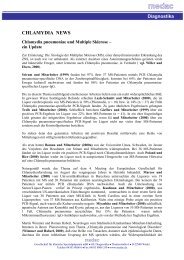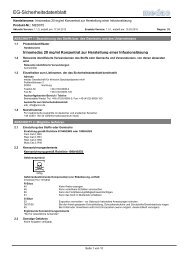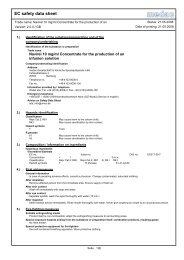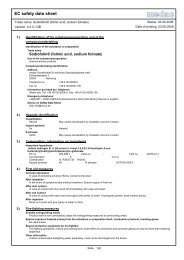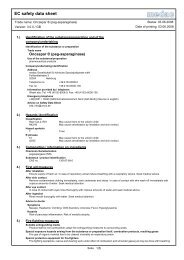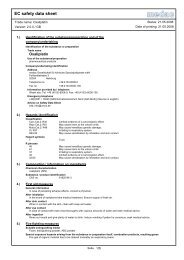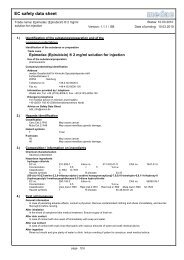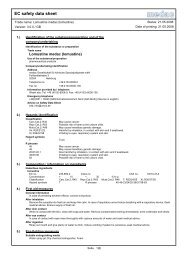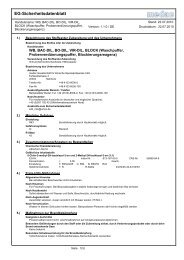asparaginase - medac GmbH
asparaginase - medac GmbH
asparaginase - medac GmbH
You also want an ePaper? Increase the reach of your titles
YUMPU automatically turns print PDFs into web optimized ePapers that Google loves.
EC safety data sheet<br />
Trade name: Asparaginase <strong>medac</strong> (<strong>asparaginase</strong>)<br />
Version: 3.1.0 / GB<br />
1.) Identification of the substance/preparation and of the<br />
company/undertaking<br />
Identification of the substance or preparation<br />
Trade name<br />
Asparaginase <strong>medac</strong> (<strong>asparaginase</strong>)<br />
Use of the substance/preparation<br />
pharmaceutical products<br />
Company/undertaking identification<br />
Address<br />
<strong>medac</strong> Gesellschaft für klinische Spezialpräparate mbH<br />
Fehlandtstrasse 3<br />
20354 Hamburg<br />
Telephone no. +49-4103-8006-0<br />
Fax no. +49-4103-8006-100<br />
Information provided by / telephone<br />
Wedel site: Tel: +49 (4103)-8006-0; Fax: +49 (4103)-8006-100<br />
Emergency telephone<br />
+49(0)551 / 19240 {Giftinformationszentrum Nord (GIZ-Nord)} (Service in english)<br />
Advice on Safety Data Sheet<br />
sdb_info@umco.de<br />
2.) Hazards identification<br />
Classification<br />
Repr.Cat.2; R61 May cause harm to the unborn child.<br />
R42/43 May cause sensitisation by inhalation and skin contact.<br />
Hazard symbols<br />
T Toxic<br />
R phrases<br />
61 May cause harm to the unborn child.<br />
42/43 May cause sensitisation by inhalation and skin contact.<br />
3.) Composition / information on ingredients<br />
Chemical characterization<br />
Asparaginase<br />
Substance / product identification<br />
CAS no. 9015-68-3<br />
EC no. 232-765-3<br />
4.) First aid measures<br />
page: 1(5)<br />
Status: 17.02.2009<br />
Date of printing: 17.02.2009<br />
After inhalation<br />
Ensure supply of fresh air. In case of respiratory arrest induce breathing with a respiratory device. Seek medical advice.<br />
After skin contact<br />
Remove contaminated clothing immediately, even underwear and shoes. In case of contact with skin wash off immediately with<br />
copious amounts of water. Seek medical attention.<br />
After eye contact<br />
In case of contact with eyes rinse thoroughly with copious amounts of water and seek medical advice.<br />
After ingestion<br />
Rinse mouth thoroughly with water. Seek medical attention.<br />
Advice to doctor<br />
Symptoms<br />
Nausea; Headache; Vomiting; Central nervous system disorders. Anorexia; Fever; Hyperglycaemia<br />
Hazards<br />
Risk of pancreas inflammation. Risk of medulla atrophy.<br />
5.) Fire-fighting measures<br />
Suitable extinguishing media<br />
Water spray jet; Carbon dioxide; extinguishing powder; Dry chemical extinguisher; Foam
EC safety data sheet<br />
Trade name: Asparaginase <strong>medac</strong> (<strong>asparaginase</strong>)<br />
page: 2(5)<br />
Version: 3.1.0 / GB<br />
Status: 17.02.2009<br />
Date of printing: 17.02.2009<br />
Special protective equipment for fire-fighters<br />
Fire-fighting operations, rescue and clearing work under effect of combustion and smoulder gases just may be done with breathing<br />
apparatus.<br />
6.) Accidental release measures<br />
Personal precautions<br />
Cordon and mark contaminated area. Personal protection equipment for removal of unintentional contamination or in the event of<br />
rupture :<br />
- Overshoes<br />
- liquid-proof protective long-sleeved coat with close-fitting sleeve-band<br />
- protective goggles with side protection shield<br />
- protective gloves<br />
- Protective face mask min. P2 according to the provisions of the professional organisation "Rules for use of breathing<br />
apparatuses"<br />
- cut cellulose in sufficient quantity<br />
- receptacle and waste container, shovel<br />
Environmental precautions<br />
Do not allow to enter drains or waterways.<br />
Methods for cleaning up/taking up<br />
Remove immediately and appropriately soiling. A further spreading of spillage on the floor with footwear has to be avoided. Keep<br />
ready a decontamination kit. Take-up of liquid drugs spill.<br />
Cover contaminated area carefully using disposable cloth or cellulose, so that the liquid is completely absorbed.<br />
Take-up of dry solid matters:<br />
Cover with several layers of cellulose contaminated area carefully over its whole surface, so that the cellulose can be wetted<br />
cautiously from above. A dispersal must be avoided.<br />
Take-up of glass breakage:<br />
Use of suitable means and use of an additional pair of protective gloves.<br />
Clean thoroughly contaminated areas.<br />
Decontamination procedure for handling exposed persons:<br />
• Remove contaminated clothes immediately.<br />
• As for prevention, shower thoroughly.<br />
• After direct contact with skin, seek medical advice.<br />
• In case of eye contact, rinse with isotonic saline solution and seek medical advice.<br />
• Prepare a full accident report / make a record in the accident book.<br />
Additional informations (chapter 6)<br />
Refrain from a chemical inactivation as no standard method exists for inactivation. In many cases strong acids or lyes are<br />
necessary; optionally oxidants such as hypochlorite solution can also be used. Inactivating agents must be added in abundance<br />
and left for a longer period of time to take effect. One would be constrained to render innocuous a CMR substance using<br />
“hazardous substances” which are substances of concern. The use of heat to inactivate in case of spills is all but impossible<br />
because of the high temperatures. Likewise it is possible that the described methods release other, toxic artefacts.<br />
Chemical inactivating method and combustion temperature of Asparaginase:<br />
- Deactivation with strong acids or bases (protein denaturing)<br />
- Thermal destruction with at least 800°C<br />
References:<br />
Barth, J.(2007): Zytostatikaherstellung in der Apotheke, deutscher Apotheker Verlag<br />
Allwood, M., Wright, P. (1997): The cytotoxics handbook, 3rd edition. Radcliffe Medical Press Ltd. 18 Marcham Road Abingdon<br />
Oxon OX14 1AA, UK<br />
7.) Handling and storage<br />
Handling<br />
Advice on safe handling<br />
Work only in fume cupboards. Production of the drug prepared for application using the Laminar Air Flow (safety bench category<br />
2). Avoid absolutely dust formation and dust depositation. Open and handle container with care. Only qualified and trained persons<br />
are authorised to handle<br />
Advice on protection against fire and explosion<br />
Do not smoke. Keep away from sources of ignition and flames.<br />
Storage<br />
Further information on storage conditions<br />
Keep container tightly closed in a well-ventilated place. Protect from heat and direct sunlight.<br />
8.) Exposure controls / personal protection<br />
Exposure limit values<br />
N O N E
EC safety data sheet<br />
Trade name: Asparaginase <strong>medac</strong> (<strong>asparaginase</strong>)<br />
Personal protective equipment<br />
Respiratory protection<br />
If ventilation insufficient, use a respiratory protection apparatus.<br />
Respiratory filter (part): min. P2<br />
page: 3(5)<br />
Version: 3.1.0 / GB<br />
Status: 17.02.2009<br />
Date of printing: 17.02.2009<br />
Hand protection<br />
Disposable gloves with long gauntlet and, if possible, revolving sleeve made of natural Latex, PVC or synthetics with tight closing<br />
band around the gauntlet (i.e. Biogel®Standard; Biogel®Skinsense or Biogel®Indicator)<br />
- unpowdered, poor protein content, close-fitting, firm surface<br />
- quality requirements according to DIN EN 374<br />
- finger area designed with double wall thickness<br />
- advantageous: dyed glovesrecommendation<br />
- Wearing of two pairs of gloves (i.e. Biogel®Indicator)<br />
Material thickness > 0,02 mm<br />
Eye protection<br />
Safety glasses (EN 166); Safety glasses with side protection shield (EN 166)<br />
Skin protection<br />
Protective clothing; Liquid-proof protective long-sleeved coat with close-fitting sleeve-band obligatory.<br />
General protective and hygiene measures<br />
Do not eat, drink or smoke during work time. Remove soiled or soaked clothing immediately. An antechamber equipped with<br />
separated storage facilities must exist for changing (protective clothes and normal clothes) before the working space (lock). At<br />
work do not eat, drink, smoke or take drugs. Keep separated from food-stuffs and feed-stocks.<br />
9.) Physical and chemical properties<br />
General information<br />
Form solid<br />
Important health, safety and environmental information<br />
Solubility in water<br />
Remarks soluble<br />
10.) Stability and reactivity<br />
Conditions to avoid<br />
No hazardous reactions known.<br />
11.) Toxicological information<br />
Acute toxicity<br />
Acute oral toxicity<br />
LD50 7500 mg/kg<br />
Species rat<br />
Reference substance Asparaginase<br />
LD50 5000 mg/kg<br />
Species mouse<br />
Reference substance Asparaginase<br />
Acute dermal toxicity<br />
Remarks No data available.<br />
Acute inhalational toxicity<br />
Remarks No data available.<br />
Acute toxicity / further data<br />
LD50 7568 mg/kg<br />
Species rat<br />
Route of exposure i.v.<br />
Reference substance Asparaginase<br />
LD50 136 mg/kg<br />
Species mouse<br />
Route of exposure i.v.<br />
Reference substance Asparaginase<br />
LD50 227 mg/kg<br />
Species cat<br />
Route of exposure i.v.<br />
Reference substance Asparaginase<br />
LD50 227 mg/kg<br />
Species dog<br />
Route of exposure i.v.<br />
Reference substance Asparaginase
EC safety data sheet<br />
Trade name: Asparaginase <strong>medac</strong> (<strong>asparaginase</strong>)<br />
Irritant/corrosive effects<br />
Irritant effect on skin<br />
Remarks No data available.<br />
Irritant effect on eyes<br />
Remarks No data available.<br />
Sensitisation<br />
Remarks No data available.<br />
page: 4(5)<br />
Version: 3.1.0 / GB<br />
Effects after repeated or prolonged exposition (subacute, subchronic, chronic)<br />
Mutagenicity<br />
Remarks No data available.<br />
Status: 17.02.2009<br />
Date of printing: 17.02.2009<br />
Reproduction toxicity<br />
Remarks Indications of toxic effects are available from reproduction studies in animals.<br />
Carcinogenicity<br />
Remarks No data available.<br />
Experience in practice<br />
Allergic reaction possible.<br />
12.) Ecological information<br />
Other adverse effects<br />
Ecological data are not available.<br />
13.) Disposal considerations<br />
Product<br />
Allocation of a waste code number, according to the European Waste Catalogue, should be carried out in agreement with the<br />
regional waste disposal company.<br />
Packaging<br />
Uncontaminated packaging may be taken for recycling.<br />
Packaging that cannot be cleaned should be disposed off as product waste.<br />
14.) Transport information<br />
Other information (chapter 14.)<br />
No hazardous material as defined by the transport regulations.<br />
Containerise toxic drugs in unbreakable, liquid-proof and tight closing containers<br />
Marking of transport containers:<br />
Name and address of patient or surgery or hospital ward<br />
if necessary label: „Caution CMR-substance“<br />
if necessary label:„refrigerated ware“<br />
if necessary label:„Caution breakable glass“,and instructions for the event of breakage<br />
Heat-sealing of primary containers recommended.<br />
15.) Regulatory information<br />
Labelling in accordance with EC directives<br />
The product is classified and labelled in accordance with EC Directive 67/548/EC.<br />
EC no. 232-765-3 (Asparaginase)<br />
Hazard symbols<br />
T Toxic<br />
R phrases<br />
61 May cause harm to the unborn child.<br />
42/43 May cause sensitisation by inhalation and skin contact.<br />
S phrases<br />
53 Avoid exposure - obtain special instructions before use.<br />
1/2 Keep locked up and out of the reach of children.<br />
3/7/9 Keep container tightly closed in a cool, well-ventilated place.<br />
22 Do not breathe dust.<br />
23 Do not breathe gas/fumes/vapour/spray (appropriate wording to be specified by the manufacturer).<br />
24 Avoid contact with skin.<br />
36/37/39 Wear suitable protective clothing, gloves and eye/face protection.<br />
45 In case of accident or if you feel unwell, seek medical advice immediately (show the label where<br />
possible).<br />
Special labelling for certain preparations<br />
"Restricted to professional users"
EC safety data sheet<br />
Trade name: Asparaginase <strong>medac</strong> (<strong>asparaginase</strong>)<br />
Version: 3.1.0 / GB<br />
Restriction of occupation<br />
Observe employment restrictions for young people.<br />
Observe employment restrictions for child bearing mothers and nursing mothers.<br />
Council Directive 96/82/EC on the control of major-accident hazards involving dangerous substances<br />
Remarks Annex I: not listed.<br />
National regulations<br />
page: 5(5)<br />
Status: 17.02.2009<br />
Date of printing: 17.02.2009<br />
Other regulations, restrictions and prohibition regulations<br />
Adhere to : TRGS 525 "Handling of hazardous substances in facilities for human medical<br />
care".<br />
BGI 754: "Safer handling with dangerous substances in the pharmaceutical industry"<br />
16.) Other information<br />
Further information<br />
The information is based on our current knowledge however it does not represent a guarantee of product properties nor does it<br />
create any legal obligation.<br />
Processing notes Please read packing specification of the drug for additional drug related information.<br />
Data in the safety data sheet refer to the substance in the tube.<br />
Sources of key data used to compile the data sheet:<br />
EC Directive 67/548/EC resp. 99/45/EC as amended in each case.<br />
Regulation (EC) No 1907/2006 (REACH) as amended in each case.<br />
EC Directives 2000/39/EC, 2006/15/EC as amended in each case.<br />
National Threshold Limit Values of the corresponding countries as amended in each case.<br />
Transport regulations according to ADR, RID, IMDG, IATA as amended in each case.<br />
The data sources used to determine physical, toxic and ecotoxic data, are indicated directly in the corresponding chapter.<br />
Department issuing safety data sheet<br />
UMCO Umwelt Consult <strong>GmbH</strong> - D-21107 Hamburg, Georg-Wilhelm-Strasse 183b, Tel.: +49(40)41921300, Fax:<br />
+49(40)41921378, e-mail: umco@umco.de.<br />
Ready-made medical preparations are not ruled by the chemical’s act, so that the submission of a safety data sheet is not<br />
obligatory. Medac, however, opts for this form because the safety data sheet constitutes a reliable source of information regarding<br />
the handling of hazardous substances and preparations, and because many occupational safety measures are basing on the<br />
safety data sheet structure.



